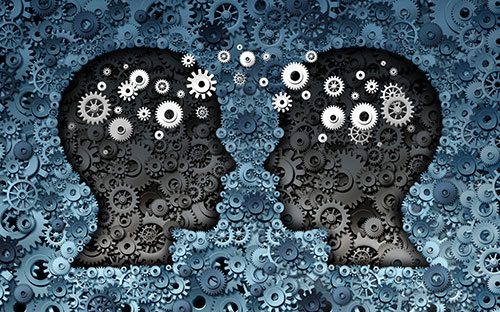
Mom and baby deeply in rapport at unconscious level
Watch a pre-verbal baby, snuggling in his mother’s arms, and notice the unwavering intensity of their shared gaze. As the mother’s smile increases, the baby breaks the rhythm of feeding, pauses briefly, and something magical happens…he cracks his first smile. Without any conscious thought, you find yourself smiling too!
This is an example of an exquisite exchange of love – as well as a highly primitive cognitive phenomenon known as unconscious ‘modelling’.
How is it we accept this deeply neurological connection between humans to understand how babies learn to ‘walk and talk’, form values between right and wrong, and acquire cultural and generational influences — yet we are slow to acknowledge this same ‘transfer of neural data’ is universal between mature adults – whether in the home, the social scene or the corporate office?
The answer to this question is waiting in the shadows – about to be revealed.
Propelled by vast advancements in lab and brain imaging technologies, the field of study known as neuroscience has exploded in the past decade. An audacious discovery of how humans are unconsciously connected via what is now known as the brain’s ‘mirror neurons’ was substantiated in findings published by Rizzolatti (1996)[i].

A mirror neuron connection between two or more people happens naturally at the unconscious level
Studies done in the early 1990’s, first using monkeys as test subjects and more recently human beings, showed how certain neurons in several parts of the brain are discharged both when a monkey (or human) performs a certain motor act (e.g., grasping an object) and when it (monkey or human) observes another individual performing that same or another similar motor act.
At the forefront in this study of human potential is the field of NLP – Neuro Linguistic Programming. In the early 1970’s, more than twenty years before mirror neurons were known to exist, NLP co-creators Richard Bandler and John Grinder explicated patterns of human functioning through a process of unconscious (mirror neuron) uptake. By developing a mirror neuron connection they were able to successfully decode the performance strategies of several people that were considered to be geniuses in their field of endeavour. While Richard and John didn’t have scientific evidence for what they were doing back then, they created a process, now referred to as ‘Real NLP Modeling’ that can now be understood explicitly based on Rizzolati’s neurological findings.
The earliest models in NLP, originally applied as approaches within the field of therapy, were designed for establishing and maintaining deep rapport between individuals and to calibrate unconscious physiological responses. For it is through the establishment of an ‘unconscious connection’ – outside the awareness of the individual – that deep rapport exists, much similar to the rapport between mother and child.
Knowing this, what happens when the behaviours and actions of leaders are being modelled by the people closest to them via the unconscious activation of mirror neurons? How easy is it to mimic the behaviours of other humans? Observe a busy social bar scene and you’ll find ample evidence it’s so easy, it’s startling.
Most people can cite examples when they were affected by another person’s ‘mood’ or ‘state’. In environments where people are operating in close proximity (and have established rapport) the transfer of one person’s ‘energy’ can happen in a flash. What if you are the boss, and your day isn’t going as planned? Unless you’ve developed the skills to quickly shift your internal state, your brain will be sending out mirror neuron generating ‘bad vibes’ that can quickly impact the performance of the entire team. And like a row of dominoes, once an unresourceful state is activated it can be a challenge to ‘shake it off’.
So, if our brains are hard wired to map behaviours of another person without us even knowing – how can we stop it? And how self aware are we of the type of vibes we’re sending out to others?
In our rapidly advancing society, a lack of self awareness is no longer an accepted excuse for not changing one’s behaviour. Employers are beginning to understand the impact of a lack of self- awareness. More and more organizations are wanting people in their workplace that are autonomous and can coach themselves. The ability to monitor one’s own performance is readily becoming a highly sought after skill.
Interest in the practice of holistic self-management is growing rapidly. A recent new change model called New Code NLP (by co-creators Dr John Grinder and Carmen Bostic St Clair) is designed specifically for autonomous self-coaching. A foundational principle of New Code NLP being a connection with the unconscious to tap into tacit skills and knowledge stored below conscious awareness. Together with an ‘attention to intention’; flexibility of behaviour and willingness to quickly shift internal state; and identifying pre-conscious triggers as choice points for new behaviours – New Code NLP is a highly effective and ecological methodology for achieving consistent high performance. This is encouraging news for anyone seeking tools to monitor their own performance, for autonomy and continuous self improvement.
“Be the change you want to see in the world.” Mahatma Gandhi
With an increase of independent thinkers entering the workforce, simply demonstrating high quality performance no longer guarantees employees will follow. When a leader develops unconscious rapport first, before demonstrating the performance they want to see, modeling will happen more naturally. And whether they are aware of it, or not, employees will feel more motivated to follow their lead guided by their mutual mirror neuron connection.
Sources
Mirror neurons: from discovery to autism, Giacomo Rizzolatti · Maddalena Fabbri-Destro, Published online: 18 September 2009 © Springer-Verlag 2009
Coaching with Neuro Linguistic Programming (NLP), by Bill Phillips and Alessandro de Vita Zublena of ADZ Conseil Coaching for Leaders, and The International Coaching Group based in Lausanne, Switzerland.
Whispering in the Wind, by Carmen Bostic St Clair and John Grinder. ISBN 0-9717223-0-7
Jacquie Nagy is a Professional Speaker, Certified Neuro Linguistic Programming (NLP) Master, Trainer and Coach, Certified Adult Educator (CAE) and has over 25 years experience as a successful corporate and private business leader and trainer. She is the founder and owner of Holistic Directions Inc. 2008 based in Winnipeg, Manitoba offering certification courses in Classic Code NLP, New Code NLP and NLP Master Practitioner.
Like our Facebook Page: Jacquie Nagy, Presenting Holistic Directions
Join our Meetup: NLP Cafe: The Art of Self-Coaching: Authentically Speaking
Jacquie is the creator of Holistic Self-Coaching™ workshops and webinars for autonomous, self-directed personal development, inspiring leaders to be more confident, authentic and resilient. Her workshops and courses are designed so learning is experiential leading to a higher sense of self-awareness, self-discovery, more resourceful actions and behaviours, and clarity of outcomes and intentions. Take the first steps to your bigger and better life now. Visit www.holisticdirections.com for more information.

It is pretty amazing how far back this type of thing goes. There is also so much that we can learn by studying the unconscious, I appreciate all of your information about this. I have been wanting to start a career in this field, do you have any further tips for how I should get started? Thank you for such a helpful article!